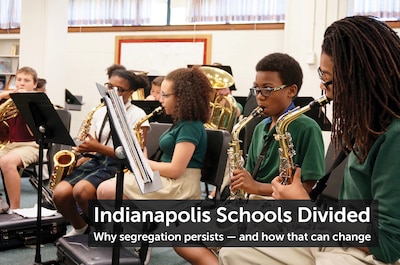Top Indiana Democrats running for statewide office offered few concrete ideas when asked how the state should step in to help Indianapolis schools reduce segregation.
John Gregg, the Democrat candidate for governor, and state Superintendent Glenda Ritz both toured the J. Everett Light Career Center in Washington Township this morning, where they were asked what role the state should play in making sure schools are balanced both racially and socioeconomically.

Gregg said he didn’t know that resegregation had become an issue. He partially blamed the legislature’s promotion of school choice — which includes taxpayer-funded vouchers for private school tuition, charter schools and parents’ ability to choose schools outside their home districts — for some of the problem.
“I’m going to check into that because I was not aware of that,” he said. “I do imagine part of it comes because the legislature allows the choice.”
A series from Chalkbeat and the Indianapolis Star has highlighted how in the years since the city began its mandatory busing of black students to township schools in order to desegregate county schools, some inner-city schools have become more segregated.
Segregated schools, particularly in low-income neighborhoods, tend to have fewer resources than their integrated counterparts, and there can also be negative social and academic effects on children, according to some studies. Now that Indianapolis Public Schools have seen large shifts in students, losing many white and middle-income families of all races, experts say desegregation could be more difficult to accomplish. In IPS, students are almost 75 percent black or Hispanic and about 70 percent are from low-income families.
Ritz acknowledged the importance of diversity in Marion County, and she, too, brought up school choice and vouchers in particular. She said her effort to pause the expansion of the state’s voucher program could perhaps play a role in decreasing segregated schools, although she didn’t elaborate.
“I have actually called for a study of the school choice programs here in the state of Indiana,” Ritz said. “Really taking a look at what is the system we have in place now and how is that impacting (state finances, student achievement and diversity).”
In a recent report on Indiana’s voucher program — one of the largest in the country — state officials compiled data showing that since the program began five years ago, the percentage of black and Hispanic students who use the program has decreased, while the percentage of white students using the program has increased. Indiana has also seen more affluent families take advantage of vouchers, though the original goal of the program was to provide more options to low-income kids.
But while research shows that unfettered school choice programs can, in fact, make segregation worse, experts also say that reducing school segregation has to be a very intentional goal for districts, cities and states — not just a byproduct of other policy.

